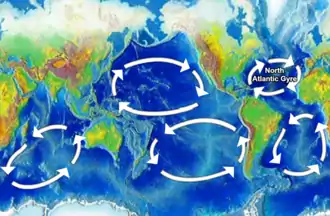North Atlantic garbage patch
The North Atlantic garbage patch is garbage patch of man-made marine debris found floating within the North Atlantic Gyre, originally documented in 1972.[1] Based on a 22-year research study conducted by the Sea Education Association, the patch is estimated to be hundreds of kilometers across in size, with a density of more than 200,000 pieces of debris per square kilometer.[2][3][4][5] The source of the garbage originates from human waste traveling from the rivers into the ocean and mainly consists of microplastics.[6] The garbage patch is a large risk to wildlife and humans through plastic consumption and entanglement.[7] There have only been a few awareness and clean-up efforts for the North Atlantic garbage patch such as The Garbage Patch State at UNESCO and The Ocean Cleanup, as most of the research and cleanup efforts have been done for the Great Pacific garbage patch, a similar garbage patch in the Great Pacific.[8][9]

Characteristics
Location and size
The patch is located from 22°N to 38°N and its western and eastern boundaries are unclear.[5] The debris zone shifts by as much as 1,600 km (990 mi) north and south seasonally, and drifts even farther south during the El Niño-Southern Oscillation, according to the NOAA.[3] The patch is estimated to be hundreds of kilometers across in size,[3] with a density of more than 200,000 pieces of debris per square kilometer (one piece per five square metres, on average).[5][10] The concentration of plastic in the North Atlantic garbage patch has stayed mostly constant even though the global plastic production has had a five-fold increase over the 22 year study.[11] This may be caused by the plastics sinking beneath the surface or breaking down into smaller pieces that can pass through the net.[11]
Sources
The North Atlantic garbage patch originates from human waste that travels from continental rivers into the ocean.[12] Once the trash has made it into the ocean, it is centralized by gyres, which collect trash in large masses.[11] The surface of the garbage patch consists of microplastics such as polyethylene and polypropylene which make up common household items.[6] Denser material that is thought to exist under the surface of the ocean includes plastic called polyethylene terephthalate that is used to make soft drink and water bottles.[6] However, these denser plastics are not observed in the North Atlantic garbage patch because the methods to collect samples only capture the surface microplastics.[6]
Research
A joint study by the Sea Education Association, Woods Hole Oceanographic Institution, and the University of Hawaii at Manoa collected plastic samples in the western North Atlantic and Caribbean Sea from 1986 to 2008.[2] Nearly 7,000 students from the SEA semester program conducted 6,136 surface plankton net tows on board SEA's sailing research vessels over 22 years, yielding more than 64,000 plastic pieces.[13] Nikolai Maximenko of the University of Hawaii in Honolulu developed a computer model to describe how plastics are accumulated from converging surface currents to form garbage patches.[13] The model uses data from more than 1,600 satellite-tracked trajectories of drifting buoys to map out surface currents.[5] The plastic data collected by the students at SEA validated Maximenko’s model, and researchers were able to successfully predict the plastic accumulation in the North Atlantic Ocean.[13]
Awareness and clean-up efforts

Few efforts have been made to clean up the North Atlantic Garbage Patch, as removing the microplastics “would likely cause as much harm as good because of all the other small creatures in the ocean that would get filtered out too”.[11] On 11 April 2013 in order to create awareness, artist Maria Cristina Finucci founded The Garbage Patch State at UNESCO[8] –Paris in front of Director General Irina Bokova . The federally recognized Garbage Patch State was the first of a series of events under the patronage of UNESCO and of Italian Ministry of the Environment, sparking a series of art exhibits across the world used to bring attention to the size and severity of the garbage patches and incite awareness and action.[14]
Dutch inventor Boyan Slat and his nonprofit organization The Ocean Cleanup is developing advanced technologies to rid the oceans of plastic.[9] Cleanup is planned to start in the Great Pacific Garbage Patch first, and eventually move around to the other patches across the globe.[15] Aside from cleaning the microplastics from the oceans, the Ocean Cleanup is also developing technologies to remove larger pieces of plastic from rivers, which are largely attributed as the main sources of plastic in the ocean.[12]
See also
| Look up pyroplastic in Wiktionary, the free dictionary. |
References
- Carpenter, E.J.; Smith, K.L. (1972). "Plastics on the Sargasso Sea Surface, in Science". Science. 175 (4027): 1240–1241. doi:10.1126/science.175.4027.1240. PMID 5061243.
- "Mānoa: UH Mānoa scientist predicts plastic garbage patch in Atlantic Ocean | University of Hawaii News". manoa.hawaii.edu. Retrieved 8 November 2019.
- Steve, By (4 August 2009). "Scientists study huge ocean garbage patch". Perthnow.com.au. Retrieved 10 May 2012.
- "Scientists find giant plastic rubbish dump floating in the Atlantic". Perthnow.com.au. 26 February 2010. Archived from the original on 14 April 2012. Retrieved 10 May 2012.
- Gill, Victoria (24 February 2010). "Plastic rubbish blights Atlantic Ocean". BBC News. Retrieved 10 May 2012.
- Orcutt, Mike (19 August 2010). "How Bad Is the Plastic Pollution in the Atlantic?". Popular Mechanics. Retrieved 8 November 2019.
- Sigler, Michelle (18 October 2014). "The Effects of Plastic Pollution on Aquatic Wildlife: Current Situations and Future Solutions". Water, Air, & Soil Pollution. 225 (11): 2184. doi:10.1007/s11270-014-2184-6. ISSN 1573-2932.
- "The garbage patch territory turns into a new state - United Nations Educational, Scientific and Cultural Organization". unesco.org.
- "About". The Ocean Cleanup. Retrieved 8 November 2019.
- "Scientists find giant plastic rubbish dump floating in the Atlantic | Perth Now". 14 April 2012. Archived from the original on 14 April 2012. Retrieved 6 November 2019.
- McNally, Jess (19 August 2010). "Massive North Atlantic Garbage Patch Mapped". Wired. ISSN 1059-1028. Retrieved 5 November 2019.
- "Rivers". The Ocean Cleanup. Retrieved 8 November 2019.
- Law, Kara Lavender; Morét-Ferguson, Skye; Maximenko, Nikolai A.; Proskurowski, Giora; Peacock, Emily E.; Hafner, Jan; Reddy, Christopher M. (3 September 2010). "Plastic Accumulation in the North Atlantic Subtropical Gyre". Science. 329 (5996): 1185–1188. doi:10.1126/science.1192321. ISSN 0036-8075. PMID 20724586.
- "Archived copy". Archived from the original on 14 July 2014. Retrieved 3 November 2014.CS1 maint: archived copy as title (link)
- www.theoceancleanup.com, The Ocean Cleanup. "www.theoceancleanup.com". The Ocean Cleanup. Retrieved 19 April 2018.